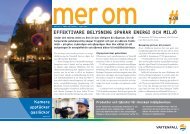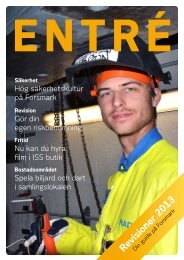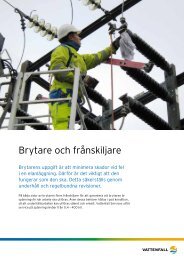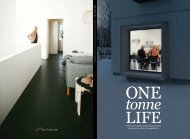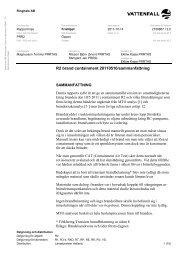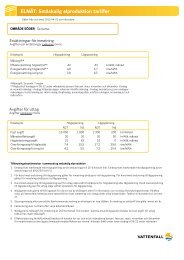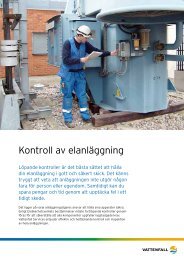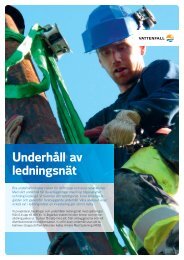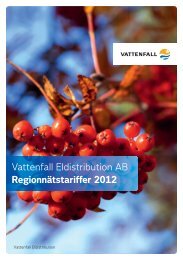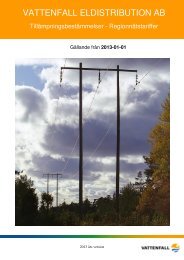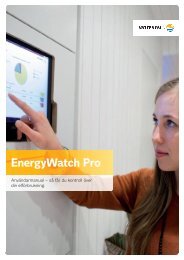This environmental impact assessment for Kriegers flak ... - Vattenfall
This environmental impact assessment for Kriegers flak ... - Vattenfall
This environmental impact assessment for Kriegers flak ... - Vattenfall
You also want an ePaper? Increase the reach of your titles
YUMPU automatically turns print PDFs into web optimized ePapers that Google loves.
) Biological surveys<br />
Extensive investigations to determine the occurrence<br />
of seabed living animals, Þ sh, mammals and ß ora have<br />
been made in the area using aircrafts, ships and divers.<br />
The occurrence of migrating and resting birds as well<br />
as migration routes <strong>for</strong> bats in the area has been investigates.<br />
All of these studies have been supplemented by<br />
documentary studies.<br />
c) Oceanographic surveys.<br />
The IfAÖ has amongst others investigated salt and oxygen<br />
contents as well as water temperature.<br />
Ice conditions have been studied by Germanische<br />
Lloyd and BSH.<br />
SMHI has made a worst case scenario estimate of<br />
the mixing of salt water between upper and lower layers.<br />
An estimate of the cumulative <strong>impact</strong> of building<br />
both the German and Swedish wind farms at <strong>Kriegers</strong><br />
Flak has also been carried out by SMHI. The hydrographical<br />
conditions of the area have been surveyed<br />
and summarised by Hydromod.<br />
5.6.2. The construction phase<br />
As previously stated, it has not yet been decided which<br />
type of foundation that will be used although it is likely<br />
that monopiles will be used in shallower (down to 25<br />
metres) and tripods in deeper waters. The foundations<br />
will be piled or drilled some 30 metres into the seabed.<br />
The aim, as far as possible, is to pile the foundations<br />
into the seabed. If this proves impossible, <strong>for</strong> example<br />
DESCRIPTION OF THE WIND FARM 31<br />
due to rocks and other solid ground, the foundations<br />
will be drilled into the seabed. In order to determine<br />
the right foundation dimension and decide whether to<br />
pile or drill, preparatory work will be carried out at<br />
each speciÞ c foundation location. <strong>This</strong> encompasses<br />
geophysical surveys, such as using sonar and<br />
sidescan sonar, seismic surveys and videotaping,<br />
as well as geotechnical surveys such as<br />
drilling, sounding, vibration testing and sampling<br />
of the seabed layers. Proposals regarding<br />
this preparatory work can be found in the<br />
SIG report (Attachment 4.3, chapter 6).<br />
Drilling at the site will be carried out<br />
inside the steel tube casing that constitutes the<br />
foundation cylinder. The drill mud is sucked<br />
through a hose leading up to the drill ship.<br />
Onboard the ship, there are two ways to make<br />
use of the mud. Either the contents are fed<br />
back into the sea where the currents are strong<br />
as is the case at the site. The currents will result<br />
in quick spreading of the sediments. The<br />
second alternative is to dispose of the mud in<br />
a container onboard the ship. The mud will<br />
sink to the bottom of the container and the water will<br />
thereafter be let back into the sea. The remaining sediment<br />
will then be released back through the foundation<br />
casing. Thereafter the piling can continue down to the<br />
target depth.<br />
To get rid of a solid obstacle, directional drilling<br />
can be applied from several angles with a smaller drill.<br />
The obstacle will be broken up and the piling can be<br />
continued.<br />
The foundation surface will be treated with biodegradable<br />
corrosion protection.<br />
The technology <strong>for</strong> assembling wind turbines is rapidly<br />
improving. It will quite soon be likely that turbines<br />
will be assembled in their entirety onshore and that<br />
large special purpose vessels will carry them to the<br />
site. As this is a cost saving and less time consuming<br />
technique it will, if possible, be used at <strong>Kriegers</strong> Flak.<br />
If this latter alternative will not be possible at the<br />
time of building the wind farm, the assembly process<br />
will look as follows:<br />
As far as possible, the assembly of the turbines will<br />
be carried out onshore. The following four components<br />
will then be assembled at the site:<br />
• The lower part of the tower





